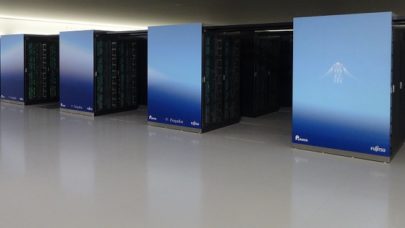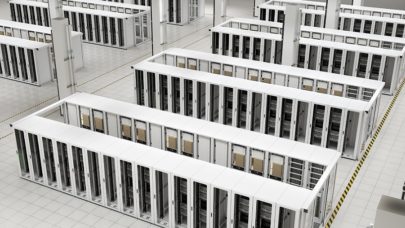
ISC 2020 Keynote: Hope for the Future, Praise for Fugaku and HPC’s Pandemic Response
June 24, 2020
In stark contrast to past years Thomas Sterling’s ISC20 keynote today struck a more somber note with the COVID-19 pandemic as the central character in Sterling’s annual review of worldwide trends in HPC. Better known for his engaging manner and occasional willingness to poke prickly egos, Sterling instead strode through the numbing statistics associated... Read more…

ISC 2020’s Student Cluster Competition Winners Announced
June 24, 2020
Normally, the Student Cluster Competition involves teams of students building real computing clusters on the show floors of major supercomputer conferences and Read more…

Hoefler’s Whirlwind ISC20 Virtual Tour of ML Trends in 9 Slides
June 23, 2020
The ISC20 experience this year via livestreaming and pre-recordings is interesting and perhaps a bit odd. That said presenters’ efforts to condense their comments makes for economic use of your time. Torsten Hoefler’s whirlwind 12-minute tour of ML is a great example. Hoefler, leader of the planned ISC20 Machine Learning... Read more…

Cluster Comp Coach Chat
June 23, 2020
In our continuing effort to provide the most comprehensive ISC20 Student Cluster Competition coverage possible, we’ve interviewed coaches from several of th Read more…

Japan’s Fugaku Tops Global Supercomputing Rankings
June 22, 2020
A new Top500 champ was unveiled today. Supercomputer Fugaku, the pride of Japan and the namesake of Mount Fuji, vaulted to the top of the 55th edition of the To Read more…

Nvidia Goes Deep with Mellanox Datacenter Net Security
June 22, 2020
When Nvidia announced its acquisition of Mellanox, the GPU leader noted that datacenters would eventually be built like high performance computers. Hence, it’ Read more…

Nvidia Nabs #7 Spot on Top500 with Selene, Launches A100 PCIe Cards
June 22, 2020
Nvidia unveiled its Selene AI supercomputer today in tandem with the updated listing of world’s fastest computers. Nvidia also introduced the PCIe form factor of the Ampere-based A100 GPU. Nvidia’s new internal AI supercomputer, Selene, joins the upper echelon of the 55th Top500’s ranks and breaks an energy-efficiency... Read more…

Meet the ISC20 Cluster Teams – Then Bet on Them!
June 21, 2020
It’s time to meet the teams competing for the ISC20 Student Cluster Competition crown in this, the first virtual Student Cluster Competition. The students h Read more…

- Click Here for More Headlines

Whitepaper
How Direct Liquid Cooling Improves Data Center Energy Efficiency
Data centers are experiencing increasing power consumption, space constraints and cooling demands due to the unprecedented computing power required by today’s chips and servers. HVAC cooling systems consume approximately 40% of a data center’s electricity. These systems traditionally use air conditioning, air handling and fans to cool the data center facility and IT equipment, ultimately resulting in high energy consumption and high carbon emissions. Data centers are moving to direct liquid cooled (DLC) systems to improve cooling efficiency thus lowering their PUE, operating expenses (OPEX) and carbon footprint.
This paper describes how CoolIT Systems (CoolIT) meets the need for improved energy efficiency in data centers and includes case studies that show how CoolIT’s DLC solutions improve energy efficiency, increase rack density, lower OPEX, and enable sustainability programs. CoolIT is the global market and innovation leader in scalable DLC solutions for the world’s most demanding computing environments. CoolIT’s end-to-end solutions meet the rising demand in cooling and the rising demand for energy efficiency.
Download Now
Sponsored by CoolIT
Whitepaper
Transforming Industrial and Automotive Manufacturing
Divergent Technologies developed a digital production system that can revolutionize automotive and industrial scale manufacturing. Divergent uses new manufacturing solutions and their Divergent Adaptive Production System (DAPS™) software to make vehicle manufacturing more efficient, less costly and decrease manufacturing waste by replacing existing design and production processes.
Divergent initially used on-premises workstations to run HPC simulations but faced challenges because their workstations could not achieve fast enough simulation times. Divergent also needed to free staff from managing the HPC system, CAE integration and IT update tasks.
Download Now
Sponsored by TotalCAE
Advanced Scale Career Development & Workforce Enhancement Center
Featured Advanced Scale Jobs:
HPCwire Resource Library
HPCwire Product Showcase
© 2024 HPCwire. All Rights Reserved. A Tabor Communications Publication
HPCwire is a registered trademark of Tabor Communications, Inc. Use of this site is governed by our Terms of Use and Privacy Policy.
Reproduction in whole or in part in any form or medium without express written permission of Tabor Communications, Inc. is prohibited.
























